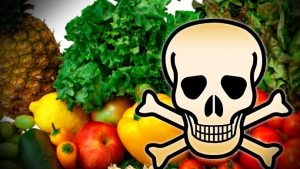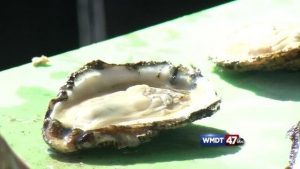My colleagues at Kansas State University would happily eat a Jimmy John’s sub sandwich loaded with raw sprouts, even though there was an outbreak ongoing, and even after expressing derision when one of my students gave a seminar and said it was a stealth ingredient.
 They’re probably still eating them.
They’re probably still eating them.
On April 11, 2014, the Baltimore City 311 system received 3 reports of illness from attendees of Conference A (Food Safety Summit). A 4th report was received on April 15. All of the reports were from conference attendees who also worked in the same building at another work location. The reporters stated that they, and
several coworkers who also attended Conference A, became ill with diarrhea between April 8 and April 10. The attendees suspected that lunch served on April 9 was the source of the illnesses. All 4 reports were assigned in the 311 system to Baltimore City Health Department’s (BCHD), Bureau of Environmental Health, Environmental Inspection Services (EIS) Food Control Section.
On April 16, BCHD, EIS identified that these reports were related and informed BCHD’s Office of Acute Communicable Diseases (ACD). An outbreak investigation was initiated on April 16 by BCHD. BCHD notified the
Maryland Department of Health and Mental Hygiene (DHMH) Division of Outbreak Investigation on April 16. Subsequently, the response proceeded as a joint state‐local outbreak investigation.
Caterer A, the primary caterer for Convention Center A, supplied food for the conference. Food was also available for purchase at vendors and concession areas in the convention center.
The observed temperature of a walk‐in cooler was within the acceptable range. No food prepared for the conference remained. Menus for the conference,
temperature logs, and recipes and procedures for food preparation were obtained.
During the same visit on April 16, Caterer A reported that during the event, about 12 employees worked in the kitchen and 40 served food. Of these, Caterer A estimated that about 20 were temporary wait staff. Two other events were held at Convention Center A that same week and were also catered by Caterer A, but neither the facility nor Caterer A received any complaints of illness from either of these groups. DHMH called the contact person that was supplied to the convention center for one of the groups to ask if attendees of that event had become ill. Caterer A also reported that two employees had been ill around the time of the outbreak. One employee who washes dishes started feeling sick the
morning of April 10 and vomited in a restroom at work that afternoon; the employee was sent home.
Another employee, who did not work in the kitchen, became ill with diarrhea and an upset stomach on April 11, with duration of symptoms less than one day. According to Caterer A management, neither of the ill employees ate food from work. Both of the ill employees submitted stool specimens for testing.
Also during the April 16 visit, Caterer A reported hearing rumors that 20 people associated with Conference A were sick and that someone working at the registration desk for the conference had been sick and could have contaminated the attendees’ badges. When additional questions were asked about
this at a later date, Caterer A reported that it was the event organizer who told them of the illnesses on April 10. The event organizer and caterer did not report the illnesses to BCHD or DHMH.
Through subsequent calls, emails, and visits with Caterer A, information about the preparation and holding of the chicken Marsala served on April 9 for lunch was obtained. The Marsala sauce was prepared the morning of April 9 and used only for the April 9 lunch. Kitchen staff might also have consumed the chicken Marsala, but the other two groups with events at Convention Center A that day
had a different menu and would not have eaten it. Leftovers would have been discarded. However, the ingredients used to make the dish were likely used for other dishes served to this group and for dishes served to other groups. Caterer A reported that precooked frozen chicken breasts were used for the
chicken Marsala. The chicken breasts were placed on sheet pans and thawed in a walk in cooler on April 7.
They were cooked the morning of April 9 and transferred to 2‐inch pans after cooking. The sauce was prepared using wine, pre‐sliced fresh mushrooms, 16 lb. buckets of frozen demi‐glace that had been placed in a walk‐in cooler 24 hours prior to thaw, and peeled fresh garlic from 5 lb. jars that was
chopped in the kitchen prior to use. The mushrooms and garlic were added first to a steam jacket kettle, followed by the wine and demi‐glace. The sauce was brought to a boil and then simmered for 30‐ 40 minutes. One hundred and fifty gallons of sauce were prepared at one time. The sauce was drained
from the steam jacket kettle into pitchers and poured directly over the pans of cooked chicken breasts.
Plastic wrap was placed over the pans. The pans were loaded into hot holding cabinets with Sternos on the bottom shelf approximately 1 hour and 20 minutes prior to service. Temperatures were recorded at that time and 2 hours later. The hot holding cabinet was plugged in while in the kitchen, unplugged
during transport, and plugged in at the location of service. Transport to the location of service occurred about 50‐60 minutes prior to the opening of the buffet. Fifteen to 20 minutes before the buffet lines opened, the pans were loaded onto pre‐warmed serving dishes with the lids closed. The plastic wrap
was removed when the buffet line opened. The above process was reported by Caterer A management and not directly observed on the day of service by DHMH or BCHD. Time intervals were reported, not recorded, by Caterer A.
Three temperature logs for the April 9 lunch service were available from Caterer A. Temperatures were recorded for 2 time points. All three logs were similar and indicated a temperature of 167°F at 10:15 am and a temperature of 151°F or 152°F at noon for the chicken Marsala. Temperatures were also recorded
for vegetable lasagna and roasted vegetables. Per Caterer A, the buffet was scheduled to be open from 11:45 am to 1:15 pm.
Stool specimens from 22 ill individuals were tested, including 1 from an individual who was excluded from the exposure analysis because their onset of illness was April 17, 2 from ill employees of Caterer A, and 19 from case‐patients. The median time between onset of illness and specimen collection was 13 days (range 4‐21 days). Two specimens from case‐patients were positive for norovirus genogroup 2 by real‐time reverse transcriptase polymerase chain reaction procedure (RT‐PCR). The specimen from the person with an onset of illness on April 17 who was excluded from the exposure analysis was positive for
norovirus genogroup 1. Testing for Salmonella, Shigella, E. coli O157, Shiga toxins, Campylobacter, rotavirus, sapovirus, astrovirus and Shiga toxins was negative.
 According to the department of health, the infections were identified in people who’d eaten Ready Pac Bistro Bowl Chicken Caesar Salad purchased at Sam’s Club stores in Maryland.
According to the department of health, the infections were identified in people who’d eaten Ready Pac Bistro Bowl Chicken Caesar Salad purchased at Sam’s Club stores in Maryland.




![Oyster-Vancouver, B.C.- 07/05/07- Joe Fortes Oyster Specialist Oyster Bob Skinner samples a Fanny Bay oyster at the restuarant. Vancouver Coastal Health now requires restaurants to inform their patrons of the dangers of eating raw shellfish. (Richard Lam/Vancouver Sun) [PNG Merlin Archive]](https://barfblog.com/wp-content/uploads/2016/05/raw.oyster-1.jpg)




